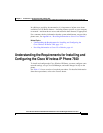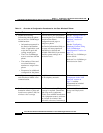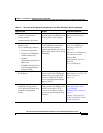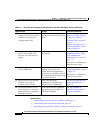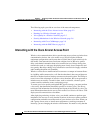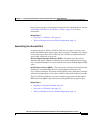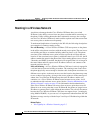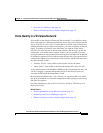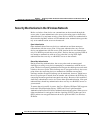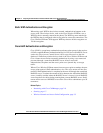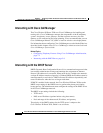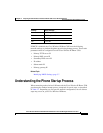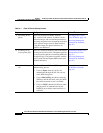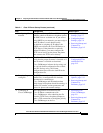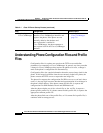
2-5
Cisco Wireless IP Phone 7920 Administration Guide for Cisco CallManager Release 3.3 or Later
OL-3930-02
Chapter 2 Preparing to Install the Cisco Wireless IP Phone 7920 on Your Wireless Network
Interactions with Components in the VoIP Network
• Overview of a Wireless LAN, page 1-4
• Wireless Network and Access Point Configuration, page 3-3
Voice Quality in a Wireless Network
Voice traffic on the Wireless IP network, like data traffic, is susceptible to delay,
jitter, and packet loss. With data transmission, these issues do not impact the end
user as critically as a voice call. To ensure that voice traffic receives timely and
reliable treatment with low delay and low jitter, you must use Quality of Service
(QoS). To manage voice traffic more efficiently, use separate virtual LANs
(VLANs) for voice and data on the network switches and the access points. By
isolating the voice traffic onto a separate VLAN, you can use QoS to provide
priority treatment for voice packets when traveling across the network. In addition
to configuring separate VLANs on the network switches, the access points that are
configured to support voice connections on the wireless LAN (WLAN) must have
the same separate VLANs:
• Auxiliary VLAN—Voice traffic to and from the wireless IP phone
• Native VLAN—Data traffic to and from the wireless PC (native VLAN)
Assign separate Service Set Identifiers (SSIDs) to the voice and data VLANs. You
can also configure a separate management VLAN in the WLAN, but do not
associate an SSID with the management VLAN.
By separating the phones onto a voice VLAN, you can ensure that voice traffic
gets priority treatment over data and management traffic resulting in lower delay
and fewer lost packets.
For more information, refer to the Cisco Wireless IP Phone 7920 Design and
Deployment Guide.
Related Topics
• Security Mechanisms in the Wireless Network, page 2-6
• Interacting with Cisco CallManager, page 2-8
• Wireless Network and Access Point Configuration, page 3-3



